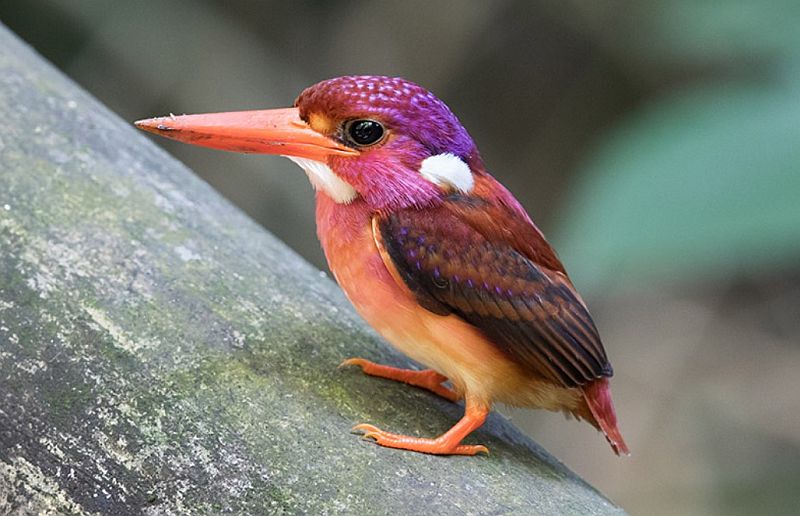Family: Royal Albatross (Diomedea epomophora) belongs to the family Diomedeidae of the order Procellariiformes in the genus Diomedea.
Habitat: Even larger than the Mollymawks the Royal Albatross (toroa) is as large as the majestic Wandering Albatross, with a wingspan of over three meters. It can be distinguished from the Wandering Albatross, however, by its white-plumaged immatures, black eyelids, and even longer bill with a black stripe along the cutting edge and more widely protruding nostrils.
Breeding only on islands around New Zealand, Royal Albatrosses rarely wander further east than South America or west of Australia. However, they travel north to Polynesia and may use the Tasman Sea as a major wintering ground and feeding area when breeding. Fish, cuttlefish, and squid make up their diet. In October, the males, who usually nest only once every two years, lead the flocks to their breeding islands. They pass through the same courtship rituals as the Wandering Albatross before laying and incubating in late November or December.
By displaying, couples that have mated for life reaffirm their bond or reunite those who have lost their partners through untoward events. Widowed males rebuild nests in their previous territories and advertise themselves, while females choose the territories in which they will nest.

Identification: Both sexes are similar, but the female is slightly smaller or with darker upper wings. Predominantly white, very thin black edges on wings underside, black under the tip. Back, tail, and upper wing to the white tip of the last wing. Becomes whiter with age. Eyes are black or dark brown. The bill is pale pink, and the upper mandible has a black edge. Feet, toes, and webs are pale grey. The northern race has the upper surface of wings black in both sexes. The immature bird is similar to adults, often with brown or black wings and heads. Downy young is white-downed.
Vocalizations: Royal Albatross calls are hoarse, and guttural when feeding and courting, with skyward whistled brays and bill-clappering.
Nest: Nesting if successful, only breeds every two years, over summer; if unsuccessful, a new attempt is made within 12 months. The nest is a large, dish mound of mud, placed about 150 meters above sea level on steep slopes. It is situated in a sheltered position in a tall grass tussock.
Breeding: Both sexes incubate in shifts of up to a fortnight or so, the male sitting the longest in a series of about 12 shifts overall. Hatching chicks take four days to break out of the egg, emerging in daylight. The chicks are brooded by both parents in shifts of one to seven days, which become shorter as they grow and cease after five weeks. Both parents feed the chick but the male often shoulders the brunt. Although they may stay on the breeding grounds all day, parents only feed the young bird once or twice, most often in the morning. Royal Albatross chicks reach peak weight at 200 days, 25 days earlier than Wandering Albatross chicks, and fledge in 235-245 days. They are fed until fledging.

Eggs: Royal Albatross lays one egg; white, often with pink-brown blotches; ellipsoidal, about 124 x 79 mm. The incubation period is about 79 days for both sexes. Young fledge in 235-245 days.
Distribution: The Royal Albatross is found in the seas of southern temperate and subantarctic latitudes (30° S and 45° S) and frequents the coastal waters of New Zealand. Hence breeding there and on Chatham Islands, Campbell Island, and the Auckland Islands. Straggles to the east and west coasts of southern Australia.
Behavior: Bill-snapping, clapping, and gulping are some of the ways they attract their mates. There are also other ways to call, such as flying with outstretched wings or extending the head and neck upwards.
Diet: Royal albatrosses eat squid and fish, with small amounts of carrion, crustaceans, and salps. In general, it forages within a radius of 1250 kilometers of its breeding site. Foraging royal albatrosses usually occur closer to continental shelves than wandering albatrosses, despite their massive distances.
Size: The Royal Albatross measures about 1150-1250 mm (44-48 inches) in length along with a 3050-3150 mm wingspan (3m or 9.8 ft).
Life Span: The average life span is 55 to 60 years.
Races: There are two races; one smaller and dark-winged, the other larger and white-winged, breeding mainly on Campbell Island where 4400 nesting pairs were found in the 1970s.
Related Reading: Grey-headed Albatross (Thalassarche chrysostoma)







